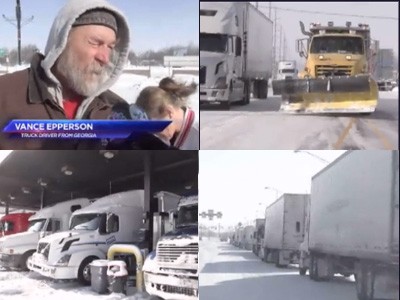It’ll take something pretty amazing to compete for headlines with the extreme weather outbreak ongoing this week across much of the United States. When people are trying to make it through the daily commute and other activities despite zero-degree temperatures, another half-foot of snow and other manifestations of Mother Nature, they won’t be in the mood for much else.
So why not cooperate with the inevitable and take a look at the economic effects of miserable winter weather? You can look at the immediate impact on workplaces, merchants, transportation and hospitality companies and other establishments that are affected when consumers hibernate from cold and snow.
For example, snow shovels, ice-melt pellets, windshield washer fluid and grocery staples are typical targets of a pre-storm run on discounters and supermarkets. What else are consumers snapping up before they hunker down? How about pet food and protective products, or snacks for wildlife? Americans spend about $4 billion on a year on bird seed and related products, according to the retail chain Wild Birds Unlimited – so check in with similar merchants in your area about how inclement weather affects sales.
How is the Arctic blast affecting post-holiday sales, and clearances of apparel and other winter goods? Is traffic in malls driven down because people prefer to stay home, or receiving a boost from stir-crazy consumers willing to brave winter weather? What about restaurants, bars, movie theaters and other places of amusement?
Who benefits when people are socked in by snowstorms? Streaming services like Netflix and Amazon Prime? Pizza and other food-delivery services? Snow-removal companies contacted by householders wanting to toss in the shovel? I bet tow services, collision-repair shops and rental-car agencies will be bracing for more calls in the coming weeks, as will plumbers, roofing repair services and other firms that can patch up damage from ice, wind and cracked pipes. You may have checked in with area hospital emergency rooms, urgent care and retail minute-clinics – but what about sales/rental of crutches, wheel chairs, braces and other aids to healing & mobility for those who may have taken a tumble or been in an auto mishap?
Looking longer term, this is a good opportunity to show how blips on the weather map can have long-range implications for a variety of industries. I’d check in with major companies on my beat – do they employ an in-house meteorologist or other weather expert? If not, where do they get their information and forecasts? Here’s an interesting article, “Inside the thriving private weather forecasting industry,” from the website WeatherWise.com, which links to hundreds of private firms on the National Weather Service site; you might check out the vendors in your state for some interesting small-biz story possibilities.
Other areas to look at:
Agriculture and food prices. I’m assuming all this cold weather isn’t good for crops and animals; while agricultural fields may be mostly fallow this time of year, some livestock deaths may occur, or other adverse consequences. What do food companies, processors and even restaurant industry insiders bracing for as we trudge through a harsh winter?
Energy. Despite a late-week drop as investors locked in gains, natural gas prices have been on the rise and inventories are declining. Time to check in with area utilities on two fronts: First, what has heating demand for natural gas and electricity done to the supply chain in the past few weeks and what is the outlook for the rest of winter? How are individual household bills trending this year and what should consumers plan for? Second, what long-range developments are afoot at your region’s largest suppliers of power and heat? Mergers, acquisitions, R&D, infrastructure improvement, etc. – if you haven’t profiled your utilities lately, a frigid winter is a good time to start.
Trucking, shipping and logistics. From bad roads to icy temps threatening perishables to backlogs at airports, no one envies the logistics manager this time of year. Whether you focus on a regional trucking fleet, or on a shipping & delivery hub, or the specifics of transporting fragile cargo like medical supplies, fresh fruit or livestock, check in with dispatchers about how winter weather may be affecting the flow of cargo and merchandise.
Also, what about rental trucks? Are more U-Hauls and Ryder trucks flying into ditches this times of year? What particular constraints – if any – do companies put on the rental of large trucks to non-professional drivers in winter?









